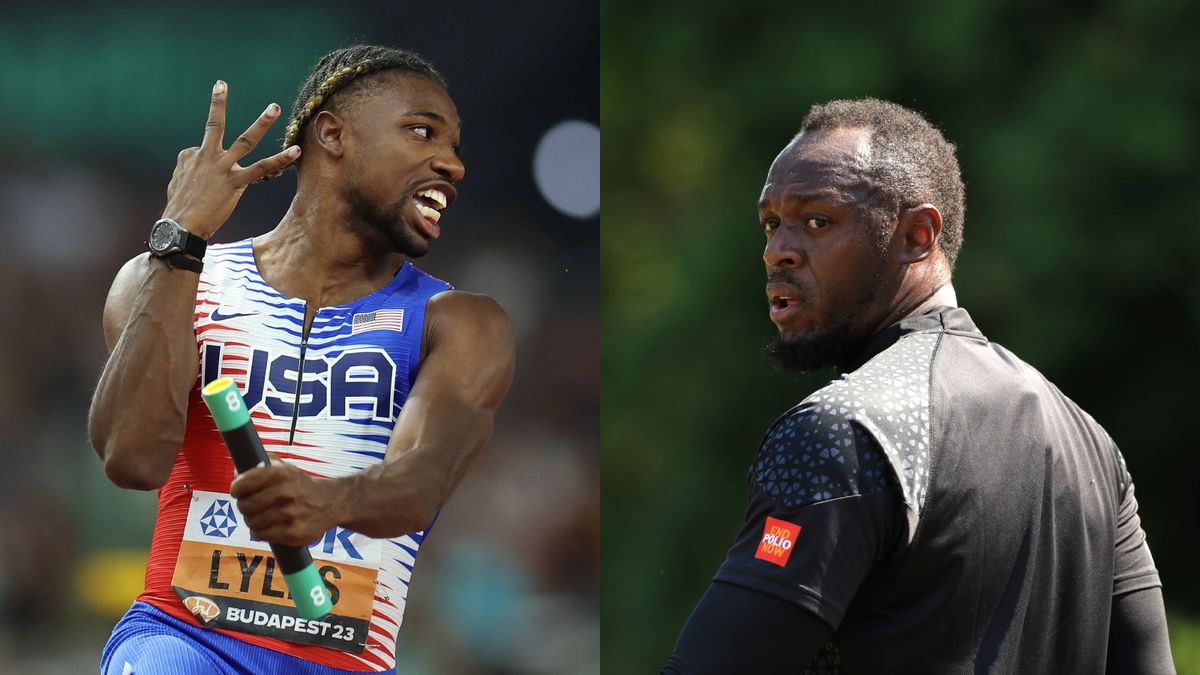
Imago
Image credits : Imago

Imago
Image credits : Imago
“America, I told you” screamed Noah Lyles, confronting the world that he kept his promise of clinching the 100m gold at the Olympics. After defeating the Jamaican sprinter Kishane Thompson with five thousandths of a second, Lyles took off his racing bib and raised it high in the air to show everyone that Nojo asserted his dominance with a photo finish of 9.784. But, when the American sprinter took his position on the start line, the spectators were pondering over just one thought – would Lyles’ slow start element affect his winning chances?
Watch What’s Trending Now!
However, even after tying for the worst reaction time (amount of time taken to respond to stimulus) of 0.178 seconds, Lyles was able to finish first and claim his first Olympic gold. And, just like Usain Bolt, the 27-year-old didn’t let his ‘slow start’ affect his podium finish. But, until the 100m semi-finals, Lyles faced an uphill battle to finish first due to his slow response time.
Noah Lyles tied for having the slowest reaction time of anyone in the field, but he still won the men's 100m final…
REACTION TIMES:
Fred Kerley 🇺🇸 – 0.108
Marcell Jacobs 🇮🇹 – 0.114
Akani Simbine 🇿🇦 – 0.149
Kenny Bednarek 🇺🇸 – 0.163
Oblique Seville 🇯🇲 – 0.171
Kishane Thompson… pic.twitter.com/mqiufabp9l— FloTrack (@FloTrack) August 4, 2024
ADVERTISEMENT
During both 100m heats and semi-finals, Nojo couldn’t finish first as he got off on a slow start, which led to some doubts about his 100m gold in finals. Nonetheless, the sprinter promised that while “Second is fine,” he’ll “make sure from here on out it’s first.” And then, when it mattered the most, Lyles had his best race at Stade de France on August 5th. Something, that even the Lightning Bolt would also relate too.
For the Jamaican sprinting prodigy, the element of ‘slow start’ has also created a hindrance on multiple occasions, and Bolt is not very much “fond of theses blocks.” In 2016, at the Golden Spike Meet, Bolt recovered from a slow start and surged through victory in 9.98 seconds. But, he felt that the “power behind the start wasn’t there,” and he needs to work on his overall reaction time.
One year later, in 2017, during the blue riband event, Bolt once again came across a “very bad” start and found himself fifth into halfway before winning the 100m heats in 10.07 seconds. “I have to get this start together because I can’t keep doing this. It’s shaky,” explained the Jamaican.
ADVERTISEMENT
But, even though both Bolt and Lyles clocked slow reaction timings in their respective pursuits, they compensate it with the good acceleration in the second half of their sprint- something that Lyles did during the 100m Olympic finals. Nevertheless, to get up to the best acceleration speed and overall reaction time, Nojo and his coach Lance Brauman worked their best to debunk spectators’ notion – ‘if only Lyles could start faster’.
ADVERTISEMENT
Lance Brauman gave Noah Lyles an ‘acceleration’ perspective
In sprinting, a good start doesn’t only mean having the quickest reaction time when the gun goes off. It’s also a precise sequence in which a sprinter bursts from the blocks, drives forward and rises slowly over 20-25 meters into an upright position. Noah Lyles, who has the best suit in 200 meters, knew he had to improve his start to become a top 100-meter runner.
However, along with having a good start, there are several other factors that come into play that ensure a good sprint. The few of them are:-
- Imparting more force on the ground
- Generating horizontal force to stay under the center of Gravity
- Adjusting angles which they are pushing
Interestingly, to help the ‘world fastest man’ work on his reaction time, Lance Brauman assisted him in navigating through all the above avenues. Back in July 2023, just a month before the World Athletics Championships in Budapest, Brauman talked about Lyles’ training regimen.

Reuters
Paris 2024 Olympics – Athletics – Men’s 100m Semi-Final 1 – Stade de France, Saint-Denis, France – August 04, 2024. Noah Lyles of United States reacts after qualifying for the final. REUTERS/Gonzalo Fuentes
Brauman mentioned, “our ability to apply force to the ground dictates your amount of clearance per step…It’s just simple power to weight ratio. As you’re able to apply more force and your body weight stays the same, you should become more powerful, which is more forceful, which is a better start.”
Though the Olympic gold medalist claimed that he is “getting closer and closer” to the best sprinting start, it seems like the 27-year-old has a lot more to do to improve his overall reaction time. However, the American track icon did improve on his acceleration. After a slow start at the 100m finals at the Olympics, he did compensate for his reaction time by accelerating his speed.
Now, as the 200m semi-finals and finals are all set to unfold at the Stade de France, Noah Lyles looks forward to bring home another golden glory. This time, the world’s fastest man will compete in his best suit. But would he be able to navigate through his slow start block, or will he use his max velocity to accelerate his way through the finish line?
ADVERTISEMENT
ADVERTISEMENT
ADVERTISEMENT
ADVERTISEMENT

